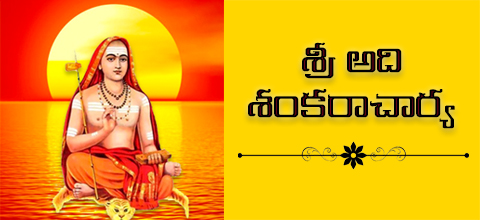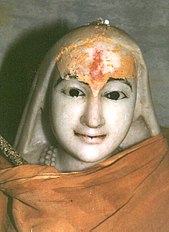 |
| Sri Adi Shankaracharya |
Adi Shankaracharya was an early 8th century Indian philosopher and theologian who consolidated the doctrine of Advaita Vedanta. He is credited with unifying and establishing the main currents of thought in Hinduism. His works in Sanskrit discuss the unity of the Ātman and Nirguna Brahman "brahman without attributes". |
Did you know?
Many of the verses and hymns we recite today are those written by Sankaracharya. Jagadguru Adishankaracharya has given us many great works such as Kanakadhara stotram, Nrissimha karaavalamba stotram, kalabhairavastakam, Annapurna ashtakam, Dwadasalinga stotram etc.
Sri Adi Shankaracharya founded five Peethas to spread the advaitha siddantha and haindava dharma in the four directions of India. Govardhana Peetham in the Puri field on the east. Dwaraka Peetham on the Dwarka on the west.
Adi Shankaracharya took a padayatra (travel by foot) from Kashmir to Kanyakumari and established the Sri Chakras in many temples for shakthi sthapana. The most famous of these temples are the Thirumala Kshetra, 18 Shakti Peethas , Jyotirlinga Kshetra and more.
Sri Adishankaracharya lives only 32 years. However, he traveled twice from east to west & north to south all over the country to spread the Hindu Philosophy amongst the people of our country when Hindu Dharma was in the verge of exteinction.
His Life
Shankara was born in the southern Indian state of Kerala, according to the oldest biographies, in a village named Kaladi sometimes spelled as Kalati or Karati. |
Philosophical tour and Disciples
While the details and chronology vary, most biographies mention that Shankara traveled widely within India, Gujarat to Bengal, and participating in public philosophical debates with different orthodox schools of Hindu philosophy, as well as heterodox traditions such as Buddhists, Jains, Arhatas, Saugatas, and Carvakas. |
 He was born to Nambudiri Brahmin parents. His parents were an aged, childless, couple who led a devout life of service to the poor. They named their child Shankara, meaning "giver of prosperity". His father died while Shankara was very young. Shankara's upanayanam, the initiation into student-life, had to be delayed due to the death of his father, and was then performed by his mother.
He was born to Nambudiri Brahmin parents. His parents were an aged, childless, couple who led a devout life of service to the poor. They named their child Shankara, meaning "giver of prosperity". His father died while Shankara was very young. Shankara's upanayanam, the initiation into student-life, had to be delayed due to the death of his father, and was then performed by his mother.
 Shankara called out to his mother to give him permission to become a Sannyasin or else the crocodile will kill him. The mother agrees, Shankara is freed and leaves his home for education. He reaches a Saivite sanctuary along a river in a north-central state of India, and becomes the disciple of a teacher named Govinda Bhagavatpada. The stories in various hagiographies diverge in details about the first meeting between Shankara and his Guru, where they met, as well as what happened later. Several texts suggest Shankara schooling with Govindapada happened along the river Narmada in Omkareshwar, a few place it along river Ganges in Kashi (Varanasi) as well as Badari (Badrinath in the Himalayas).
Shankara called out to his mother to give him permission to become a Sannyasin or else the crocodile will kill him. The mother agrees, Shankara is freed and leaves his home for education. He reaches a Saivite sanctuary along a river in a north-central state of India, and becomes the disciple of a teacher named Govinda Bhagavatpada. The stories in various hagiographies diverge in details about the first meeting between Shankara and his Guru, where they met, as well as what happened later. Several texts suggest Shankara schooling with Govindapada happened along the river Narmada in Omkareshwar, a few place it along river Ganges in Kashi (Varanasi) as well as Badari (Badrinath in the Himalayas). During his tours, he is credited with starting several Matha (monasteries), however this is uncertain. Ten monastic orders in different parts of India are generally attributed to Shankara's travel-inspired Sannyasin schools, each with Advaita notions, of which four have continued in his tradition: Bharati (Sringeri), Sarasvati (Kanchi), Tirtha and Asramin (Dvaraka). Other monasteries that record Shankara's visit include Giri, Puri, Vana, Aranya, Parvata and Sagara – all names traceable to Ashrama system in Hinduism and Vedic literature.
During his tours, he is credited with starting several Matha (monasteries), however this is uncertain. Ten monastic orders in different parts of India are generally attributed to Shankara's travel-inspired Sannyasin schools, each with Advaita notions, of which four have continued in his tradition: Bharati (Sringeri), Sarasvati (Kanchi), Tirtha and Asramin (Dvaraka). Other monasteries that record Shankara's visit include Giri, Puri, Vana, Aranya, Parvata and Sagara – all names traceable to Ashrama system in Hinduism and Vedic literature. a Hindu pilgrimage site in the Himalayas. Texts say that he was last seen by his disciples behind the Kedarnath temple, walking in the Himalayas until he was not traced. Some texts locate his death in alternate locations such as Kanchipuram (Tamil Nadu) and somewhere in the state of Kerala.
a Hindu pilgrimage site in the Himalayas. Texts say that he was last seen by his disciples behind the Kedarnath temple, walking in the Himalayas until he was not traced. Some texts locate his death in alternate locations such as Kanchipuram (Tamil Nadu) and somewhere in the state of Kerala.